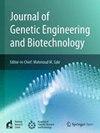The evolution of superbugs in space: a genomic perspective on pathogens in the International Space Station environment
IF 2.8
Q3 Biochemistry, Genetics and Molecular Biology
Journal of Genetic Engineering and Biotechnology
Pub Date : 2025-07-10
DOI:10.1016/j.jgeb.2025.100536
引用次数: 0
Abstract
Microgravity, pressure, and temperature variations in the International Space Station (ISS) create conditions leading to the emergence of superbugs. Due to technical issues in spacecraft, astronauts are forced to stay in ISS for extended periods; prolonged stay and exposure in stressful ISS environment weakens their immune systems, increasing susceptibility to infections. The presence of hypervirulent and antibiotic-resistant pathogens in space station is a worrisome feature as these might cause serious life-threatening infections in astronauts staying in high stress environments with weakened immune systems. In the present study, we compared antimicrobial resistance genes (ARGs) and virulence factors (VFs) in bacterial genomes from ISS with Earth counterparts. ISS genomes exhibited elevated counts of defense-related genes, particularly in E. ludwigii and E. cancerogenus. Among genes uniquely found in ISS genomes, CRISPR-Cas system components were notably prevalent. Though Earth genomes harbored higher number of ARGs overall, several species from ISS possessed modestly higher ARG counts. VFs profiling showed a slightly lower count in ISS genomes, but P. conspicua, E. ludwigii, and K. pneumoniae from ISS carried exclusive VFs linked to metal ion uptake and secretion systems, suggesting environment-driven functional adaptations. The adaptation of pathogenic bacteria in ISS is alarming and therefore periodic monitoring of bacterial genomic surveillance is important. Our findings shed light on genomic profiles in bacterial strains from both ISS and Earth, enhancing our understanding of the bacterial pathogens’ potential impact on drug resistance and pathogenicity in space-missions and the possible threat of spread from ISS.

太空中超级细菌的进化:国际空间站环境中病原体的基因组学视角
国际空间站(ISS)的微重力、压力和温度变化创造了导致超级细菌出现的条件。由于航天器的技术问题,宇航员被迫在国际空间站停留较长时间;长时间停留和暴露在紧张的国际空间站环境中会削弱他们的免疫系统,增加对感染的易感性。空间站中存在高毒力和耐抗生素病原体是一个令人担忧的特征,因为这些病原体可能会导致宇航员在高压力环境中生存,免疫系统减弱,从而导致严重的危及生命的感染。在本研究中,我们比较了来自ISS和地球的细菌基因组中的抗菌素耐药基因(ARGs)和毒力因子(VFs)。ISS基因组显示防御相关基因的数量增加,特别是在E. ludwigii和E. cancerogenus中。在ISS基因组中独特发现的基因中,CRISPR-Cas系统组分明显普遍存在。虽然地球基因组总体上拥有更多的ARG,但来自国际空间站的一些物种的ARG数量略高。VFs分析显示,ISS基因组中的VFs数量略低,但来自ISS的P., E. ludwigii和肺炎克雷伯菌携带与金属离子摄取和分泌系统相关的独有VFs,表明环境驱动的功能适应。致病菌在国际空间站的适应性是惊人的,因此定期监测细菌基因组监测是重要的。我们的研究结果揭示了来自国际空间站和地球的细菌菌株的基因组图谱,增强了我们对细菌病原体在太空任务中对耐药性和致病性的潜在影响以及来自国际空间站传播的可能威胁的理解。
本文章由计算机程序翻译,如有差异,请以英文原文为准。
求助全文
约1分钟内获得全文
求助全文
来源期刊

Journal of Genetic Engineering and Biotechnology
Biochemistry, Genetics and Molecular Biology-Biotechnology
CiteScore
5.70
自引率
5.70%
发文量
159
审稿时长
16 weeks
期刊介绍:
Journal of genetic engineering and biotechnology is devoted to rapid publication of full-length research papers that leads to significant contribution in advancing knowledge in genetic engineering and biotechnology and provide novel perspectives in this research area. JGEB includes all major themes related to genetic engineering and recombinant DNA. The area of interest of JGEB includes but not restricted to: •Plant genetics •Animal genetics •Bacterial enzymes •Agricultural Biotechnology, •Biochemistry, •Biophysics, •Bioinformatics, •Environmental Biotechnology, •Industrial Biotechnology, •Microbial biotechnology, •Medical Biotechnology, •Bioenergy, Biosafety, •Biosecurity, •Bioethics, •GMOS, •Genomic, •Proteomic JGEB accepts
 求助内容:
求助内容: 应助结果提醒方式:
应助结果提醒方式:


